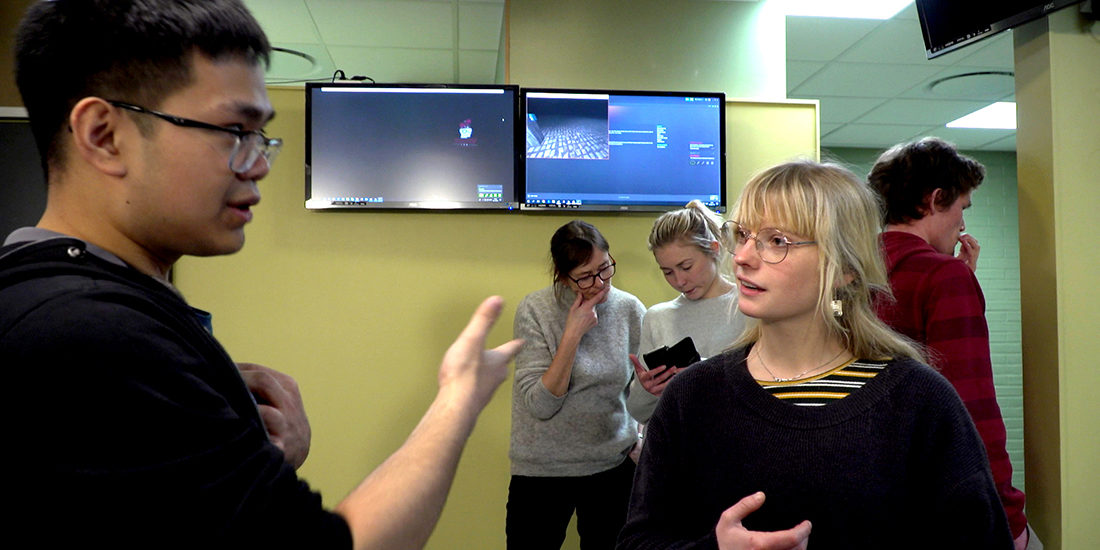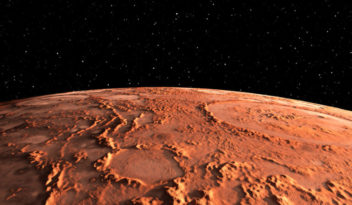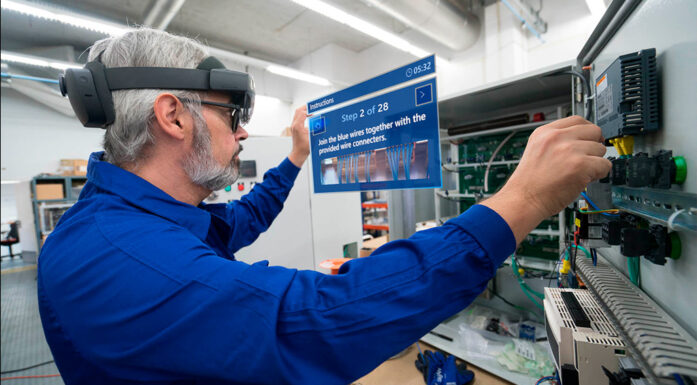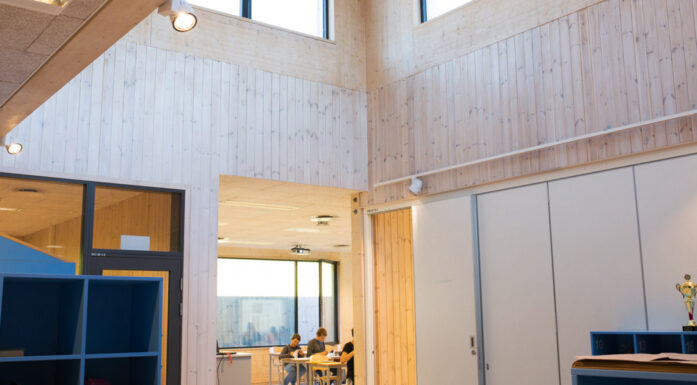Teaching on Mount Everest and Mars
In the virtual world, inaccessible places become accessible. NTNU uses virtual reality – or VR – technology to create new teaching methods.
We put on our VR headsets and wander through Trondheim’s streets and alleyways and discover the city with new eyes. We pass the imposing Nidaros Cathedral and stroll across the Old Town Bridge. It’s like a red painted belt over the Nidelva River.
One of the buttons on the VR controller that guides the excursion is activated – and the water level in the river begins to rise sharply until the water reaches the first floor of the houses along the river bank. Then it rises even more and floods into the streets of Bakklandet and other low-lying parts of the city.
Virtual Reality
- Virtual reality, often abbreviated VR, is a computer technology that allows the user to influence and be affected by a computerized environment.
- Virtual reality is an illusion that gives the user an experience of being in another, fictitious or real place.
- "Real" sensory impressions are replaced by simulated sensory impressions.
- Virtual realities are usually mediated by computer graphics, often by acoustic effects, sometimes in combination with other sensory impressions, such as odour or mechanical impulses.
- Source: Store norske leksikon (Snl.no)
Applications
- Lots of computer games are based on some form of virtual reality.
- Technology has long been used to provide training that would otherwise have been costly and/or risky, such as aircraft and boat simulators, but also in areas where 3D visualization, interaction and inclusion are important
- Virtual reality can also be used for medical treatment and research, where it is important to have good control of what the user is experiencing.
This could be the scene if Trondheim were to experience major flooding or the sea level rises.
Another button on the controller activates areas with quick clay. It turns out that rather large and densely settled neighbourhoods rest on shaky ground.
We’re able to switch from a worm’s eye view to bird’s eye view, which makes for a somewhat dizzying and different way of experiencing the city.
VR in teaching
The actual location for our journey of discovery is the expanded virtual reality lab at NTNU. This is where various VR scenarios are created and tested for use in teaching.
Virtual and augmented reality (VR and AR) have seen explosive growth in recent years, opening up new opportunities for instruction. NTNU established the VRLab as one of its innovative learning arenas. It contains advanced technology that is unrivalled in Norway.
A group of students from the Postgraduate Teacher Education programme (PPU) are trying out different VR scenarios. These are students with a bachelor’s or master’s degree in science, who study pedagogy for one year on their way to becoming secondary school teachers.
The theme of the seminar is how VR technology can be used to teach STEM subjects, and VR applications on climate change are the agenda of the day.
Article continues below video.
Watch how Postgraduate Teacher Education students test out how VR can be used in teaching. Video: Monica Lilleengen / NTNU
Exploring the seabed
The students move around with VR headsets on and gaming controllers in their hands as student lab assistants guide them.
“Very cool,” says Sofie Rettestøl Olaisen, who’s just come from virtually exploring the seabed.
“VR creates strong visual experiences. Since memory is related to emotion, you can remember things better that you’ve had strong experiences with. So VR can help you remember and learn better,” she said.
“A lot of people perceive VR as something new, and learning gets embedded more deeply when we experience new things,” she adds.
Unni Eikeseth is one of the teachers in NTNU’s Department of Teacher Education who has introduced VR to the PPU students.
“A lot of science topics, such as climate change, can seem removed from students’ everyday life. VR technology makes it easier to envision what climate change may lead to in the future,” says Eikeseth, who teaches science didactics.
Master’s degree with flood scenario
Magnus Warvik is a graduate student who has designed the VR Trondheim flooding scenario as part of his master’s thesis in interaction design.
“The goal is for the technology to be easy to understand and easy to use,” he says while guiding the students around in his VR world – up hills, between houses and along river banks and a beach promenade.
“But people are very different, so I test the scenario out on different users, and simplify and improve it all the time. The program should be engaging and fun to use, even though the topic is serious,” he says.
Norwegian language learning with VR
Two other master’s students have hit on the concept of using virtual reality for Norwegian language learning. Immigrants with higher education constitute the target audience for their app. A challenge in learning Norwegian for many immigrants is that although they use Norwegian in the classroom, they’re using their native language or English in most other contexts.
“We believe that an interactive language program in VR will help them use Norwegian more actively so that they learn the language better and faster. They’ll also get feedback on their pronunciation, which can contribute to better learning,” says Carlo Alfredo Morte, who is a master’s student in computer science.
He points out that several studies have shown that the use of VR increases students motivation for learning.
Article continues below video.
Meet master’s students Carlo Alfredo Morte and Simon Hagen Strand, who have created VR applications for learning Norwegian and to teach math. Video: Monica Lilleengen / NTNU
Visit to Mars
After several rounds in the lab, the students share their experiences with each other. Their reactions and conclusions include that it is important for the technology to be well functioning to maximize the experience.
Several students also point out that using VR in teaching works best when technology transports us into scenarios that we can’t experience in the real world – like a visit to Mars, or being a different gender or having a different skin colour.
Started with science fiction
The head of the VRLab is Ekaterina Prasolova-Førland, a professor in NTNU’s Department of Education and Lifelong Learning – and a devoted VR enthusiast. She leads the Innovative Immersive Technologies for Learning (IMTEL) research group and has probably worked longer in this field than anyone else in Norway.
“IMTEL is one of the few research groups in Norway that systematically researches VR and AR for learning and training,” says Prasolova-Førland.
She has worked with VR for fifteen years at NTNU, but has been interested in the technology since she discovered it.
“I was sold right away. I had such strong experiences, which fascinated me tremendously. My interest in this way of creating and experiencing reality is probably related to reading a lot of science fiction when I was younger,” Prasolova-Førland says.
- You might also like: Sharing a chalkboard from 300 km away
VR – technology’s Oscar
Now she’s an engine in high gear and running numerous VR projects. Several of them are being done in collaboration with the business community, including with NAV – the Norwegian welfare agency – which is about to launch the project Virtuell praksisplass (Virtual apprenticeship). This project uses game-based learning and VR technology as a tool to motivate young people and help them find their way into the job market.
VRLab and NAV received the Best Demo Award at the EuroVR 2018 conference for developing the project.
The project was also a finalist at the Breakthrough Auggie Awards (also called the “Oscars of VR/AR”), along with projects from Microsoft, Stanford and NASA, and eventually ended up among the top four in the Education category.
Trip to Mount Everest or Chernobyl
People from different fields of study use the VRLab, such as IT, geography, psychology, pedagogy, teacher education, anthropology, cybernetics and biotechnology. The lab offers various VR adventures, including the possibility to:
- explore corals on the seabed and see how they are affected by ocean acidification
- look into the interior of human cells
- climb Mount Everest
- visit Chernobyl
- visit a Syrian refugee camp
- interact with students in other cities
Surgery practice
The VRLab can also be used to practise skills in medical treatment and surgery, for example. A sister lab at Øya in Trondheim is used by medical students.
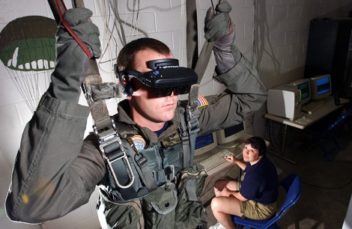
A skydiver in the US Navy trains to parachute in 2006, using a head-mounted display (HMD) that displays an artificial reality simulating the experience of a real jump. Photo: Wikimedia Commons
NTNU is collaborating with the oldest scientific library in Norway, the Gunnerus Library in Trondheim, on a project that involves preserving the cultural heritage and obtaining historical manuscripts to arouse an interest in history among young people. An image or drawing of a historic castle, for example, rises up out of the old document and appears three dimensional.
The last project on the list that is just around the corner is mathematics teaching on Mars.
The IMTEL research group regularly organizes innovation days with invited lecturers and open labs to showcase the opportunities behind VR and AR technologies.
You can follow IMTEL’s activities on Facebook: href=”https://www.facebook.com/IMTELlab/”>https://www.facebook.com/IMTELlab/
